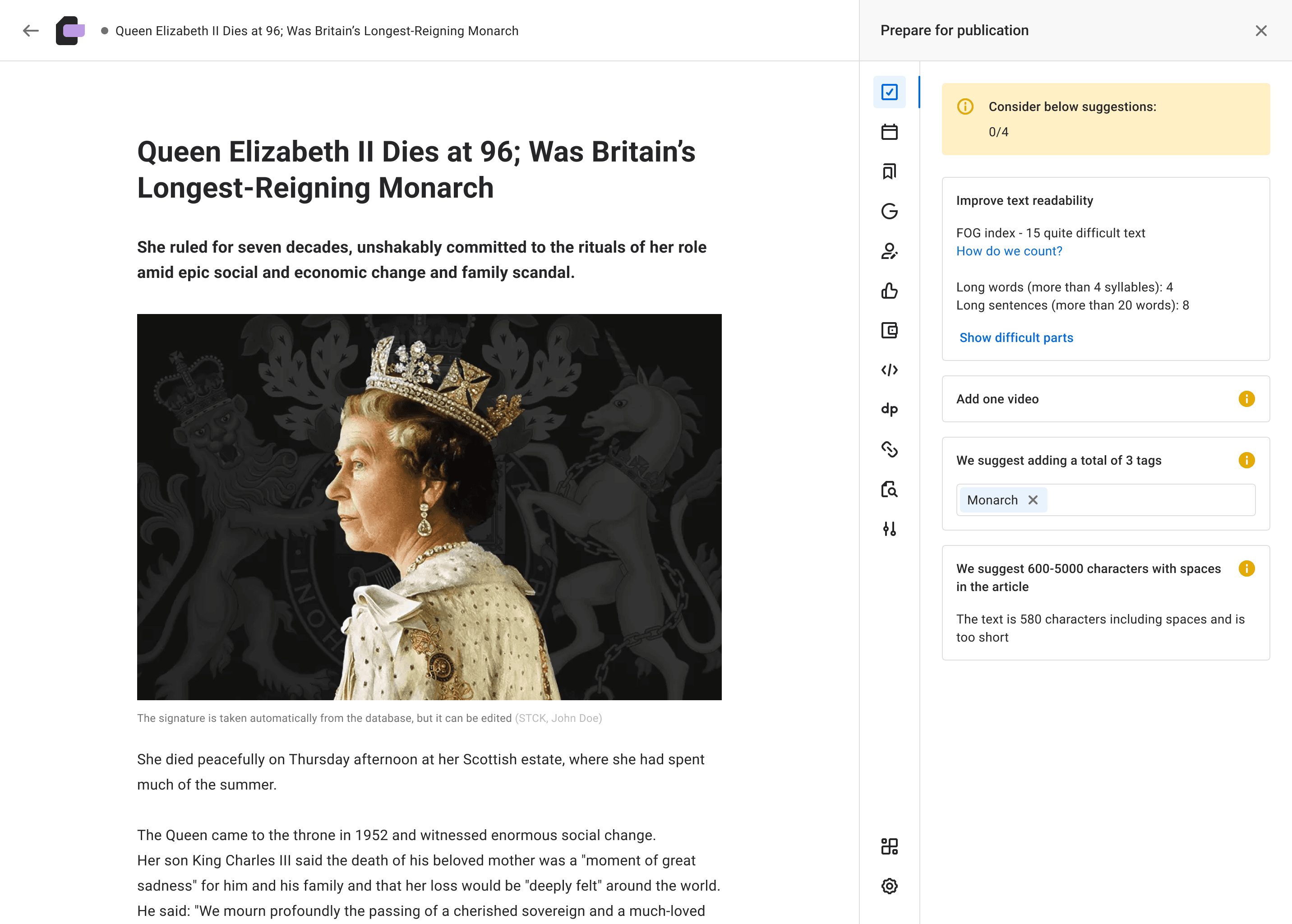Introduction to AI strategy for news organisations
8 May 2023
In this text, we will explore the multi-faceted area of AI strategy for news organisations and how AI technologies can revolutionise various aspects of journalism.
In an era defined by the rapid evolution of technology, news organisations are at a pivotal juncture where they must harness the power of artificial intelligence (AI) to adapt and succeed. As news consumption patterns change and audiences demand more personalized and relevant content, integrating AI into the strategic framework of news organizations has become not just an option but a necessity.
In this text, we will explore the realm of AI strategy for news organisations, delving into how AI technologies can revolutionise various aspects of journalism. We will discuss three key topics: automated content generation, audience analytics and personalisation, and fighting misinformation.
1) Automated content creation
In the landscape of modern journalism, where information flows ceaselessly and deadlines loom, news organisations are increasingly turning to automated content creation powered by AI. This technology promises to streamline content creation processes, enhance efficiency, and even increase the volume of coverage.
Automated content creation uses AI algorithms to analyse data, extract insights, and create coherent reports without the need for direct human intervention. Some may see this as a radical departure from traditional journalism, but it can also be seen as a complementary tool that allows journalists to focus on the more complex and investigative aspects of reporting.
Read also: Which AI tools in journalism are really worth the hype?
Watch: A concept developed by Autentika that allows journalists to input relevant data, such as stock market data, and let the AI analyse it to create a full article.
Benefits of automated content creation
-
Speed and scale: One of the main advantages of automated content creation is the ability to produce news at a rapid pace and at scale. AI algorithms can process and merge data from multiple sources and transform raw information into concise, reader-friendly articles within minutes.
-
Data-driven reporting: Automated systems excel at crunching numbers and inferring patterns from large data sets. This strength can be used to create data-driven news, such as financial reports, sports statistics analysis, and breakdowns of election results.
-
Coverage of routine topics: Everyday but important topics such as weather forecasts, financial reports, and stock market news can be efficiently covered through automated content creation, allowing journalists to focus on more complex topics.
Ethical considerations and challenges
-
Maintaining journalistic standards: When news organizations adopt automated content generation, it's important to uphold the basic principles of journalism such as accuracy, fairness, and accountability. Ensuring that AI-generated content adheres to these standards requires careful monitoring and fine-tuning of algorithms.
-
Avoiding bias: AI algorithms are susceptible to biases inherent in their training data. News organizations must take steps to identify and correct potential biases that could affect the tone or perspective of automated content.
-
Human-AI collaboration: successful implementation of automated content creation requires a balance of AI and human involvement. Journalists can oversee the process, provide context, edit, and ensure that the generated content is consistent with the publication's style and values.
Listen to Maciej Klepacki, CEO of Burda Media Polska, who discusses the topic of alogrithmic bias and exclusion in an interview with Autentika:
2) Audience analysis and personalisation
In the digital age, where news consumption is no longer one-size-fits-all, the integration of AI-powered audience analytics and personalisation has become essential for news organisations that want to effectively engage their readers.
AI technologies offer the ability to analyse large amounts of data and gain insights into readers' preferences, behaviours and interests. By using these insights, news organisations can tailor their content to the individual reader, improving the overall experience while addressing the challenges of information overload and changing audience expectations.
Read also: Why media need to learn how to swim in the AI waters
Leveraging audience insights
-
Understanding reader behaviour: AI can track reader interactions with content, such as click-through rates, time spent on articles and sharing behaviour. These insights provide valuable information about which topics resonate most with readers. This allows news organisations to use their resources effectively and produce content that matches readers' interests.
-
Segmentation and targeting: AI-powered audience analytics enable news organisations to segment their audiences based on a variety of criteria, such as demographics, geographic location and reading habits. This segmentation enables more precise targeting of content and ensures that readers receive news that is relevant and engaging to them.
6 pillars of editorial analytics at Mediahuis – with Yves Van Dooren
Balance personalisation and privacy
-
Tailored content experiences: Personalisation enhances the user experience by providing content that matches readers' interests. AI algorithms can suggest articles, videos and topics based on readers' past behaviour, creating a curated news feed that engages and informs them.
-
Privacy concerns: While personalisation offers benefits, it also raises privacy concerns and the risk of creating echo chambers. News organisations need to implement robust privacy measures and give readers control over their data to promote trust and transparency.
How three leading European newsrooms handle editorial analytics
Challenges and considerations
-
Preserving diversity: Personalisation must not lead to a narrowing of viewpoints or limited access to different viewpoints. News organisations need to strike a balance between accommodating individual preferences and ensuring that readers are exposed to a wide range of news and views.
-
Protecting against bias: AI-driven personalisation algorithms can unintentionally reinforce existing biases by recommending content that aligns with users' existing views. Implementing diverse training data and ongoing monitoring of the algorithm can mitigate this risk.
Read also: 7 bitter pills to swallow if you want AI in your newsroom
3) Fight against misinformation
Misinformation has become a major challenge, undermining public trust in news and distorting the flow of correct information. In this fight, AI has become an important tool, providing innovative solutions to detect, combat and counter false or misleading content.
By harnessing the analytical capabilities of AI, news organisations can maintain their commitment to journalistic integrity while protecting their audiences from the damaging effects of misinformation.
The role of AI in detecting misinformation
-
Automated fact-checking: AI algorithms can analyse large amounts of information from multiple sources to cross-reference claims and verify their accuracy. This technology speeds up the fact-checking process and enables news organisations to debunk false information immediately.
-
Source verification: AI can help verify the credibility of sources and authors by analysing their online presence, reputation and track record. This vetting process helps ensure that news organisations can rely on trustworthy information.
Watch: A fact-checking AI feature that helps journalists deal with news verification and ensure the accuracy of facts. It analyses news content in real time and highlights mistakes and inaccuracies.
Challenges and ethical considerations
-
Algorithmic bias: AI systems can inadvertently maintain biases in their training data. News organisations must take care to identify and minimise algorithmic biases to ensure that AI tools used to detect misinformation do not create new problems.
-
Balance between automation and human oversight: While AI can automate certain aspects of misinformation detection, human judgement remains essential. The right balance between AI automation and human oversight ensures nuanced analysis and context that machines may miss.
AI-assisted content moderation
-
Automated content review: AI algorithms can analyse user-generated content to identify potential misinformation, hate speech and inappropriate content. This technology helps news organisations maintain a healthy and responsible online discourse.
-
Improving comment sections: AI-powered moderation can create more productive comment sections by filtering out spam, offensive language and false claims. This encourages constructive dialogue on news stories.
Watch: A filter that helps prevent hateful speech in the comments. When a user posts a comment with inappropriate language, the AI urges them to change the wording.
AI in the future of journalism
The fusion of artificial intelligence and journalism is no longer a futuristic concept; it is a dynamic reality that news organizations must wholeheartedly embrace. As this text has explored, AI offers unprecedented opportunities across various dimensions of the news industry, from content creation and distribution to audience engagement and misinformation mitigation.
As news organizations integrate AI into their strategies, it is crucial to remember that technology is a means, not an end. The principles of responsible journalism—accuracy, fairness, transparency, and accountability—must continue to guide every AI-driven decision. AI's potential can only be fully realized when coupled with the human values that define the essence of journalism.



